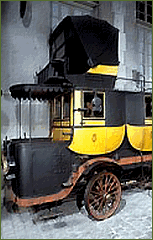|
The collection is displayed on an area of around 3200 square
metres and the museum offers its visitors some very fine examples of sleds, bicycles and
vehicles that has benefited from a large number of donations from individuals that decided
to enrich it. An important donation consisting mainly of vehicles from the 18th
century was from the Musee de Cluny, which is
a museum in Paris also known as the Musée
National du Moyen Âge.
The National Museum of the Car and Tourism is actually located in the former courtyard of
the castle kitchens of Chateau de Compiegne, which is a beautiful castle only a short trip
from the City of Paris, yet actually in the Picardie region of France.
The Musée National de la Voiture et du Tourisme is dedicated to the history of road
travel from the first coupling to the beginnings of the automobile and the period when
horse traction and car traction were in competition with eventual supremacy of the
automobile, is very well represented.
The museum shows the fascinating history of road transport, from the beginnings of
harnessing to the early years of the automobile and there are 31 vehicles that represent
its infancy in the areas of steam, electricity and then the early engine.
Within this section you will even get to see the prototype of the Jamais Contente, which
was the first electric car designed by Camille Jenatzy in 1899 and exceeded 100 kilometres
per hour.
Plus you will be able to get to see an amazing cycle collection that has an incredible
assortment of two, three and four wheeled velocipedes, from the early Dandy Horses and
Hobby Horses of the years 1817 to 1820 through to the modern bicycle of 1890 to 1920.
Through its various sections, the museum offers examples that are varied and includes
models, paintings, photographs and other objects that enrich the collection further.
But unfortunately the policy of continual collection and development has slowed down quite
dramatically over the years due to lack of space for storing and presenting the
collections, yet it is a unique testimony to the history of road traction up until the First World War.
The Chateau de Compiegne also houses another
museum, which is called the Musee du Second
Empire and these two museums plus the castle are definitely worth a visit when you are
on holiday in France.
You can reach this French museum via car from Paris by
taking the motorways A3, and then A1 and take exit 9 Chevrières or exit 10 Arsy.
However, from the direction of Lille you would need to use the motorway A1 and then take
the exit 10 Arsy.
The National Museum of the Car and Tourism is open every day of the week except for a
Tuesday.
From April through to the end of September the museum opens from 9.15am to 6pm, yet the
entry gates close one hour prior.
From the start of October through to the end of March it opens from 9.15am and then closes
at 4.30pm but as before the last entry is one hour prior to closing time.
You will be pleased to know that this museum is one of those that is free to visit on the
first Sunday of each month.
Address & Contact Details:
Le Musée National de la Voiture et du Tourisme
Château de Compiègne
Place du Général de Gaulle
60200
Compiègne
France
Telephone: 3 44 38 47 00
|
|



